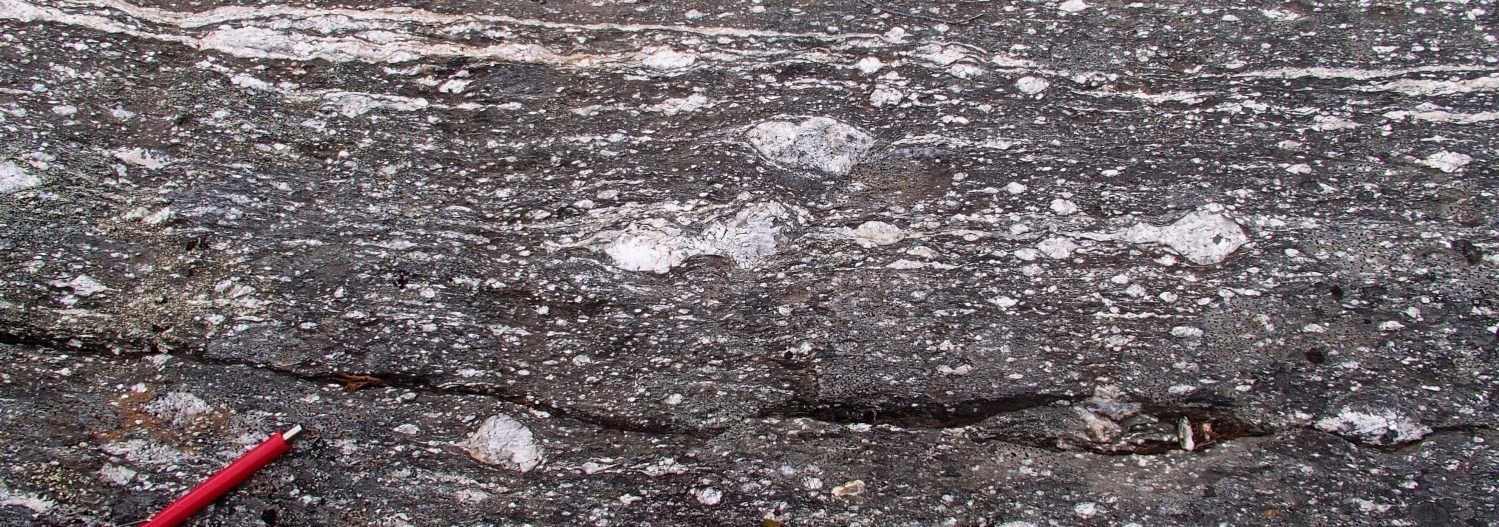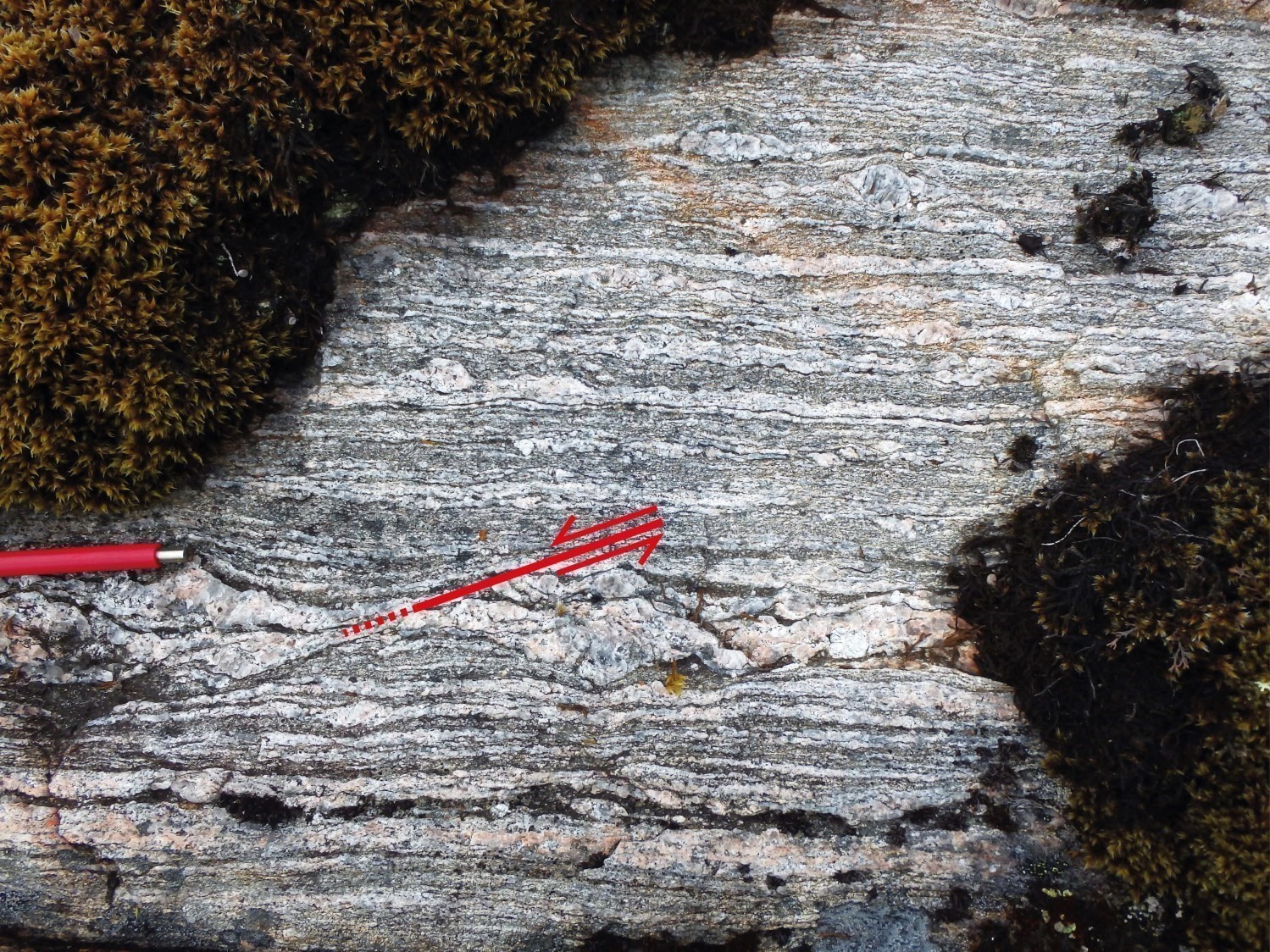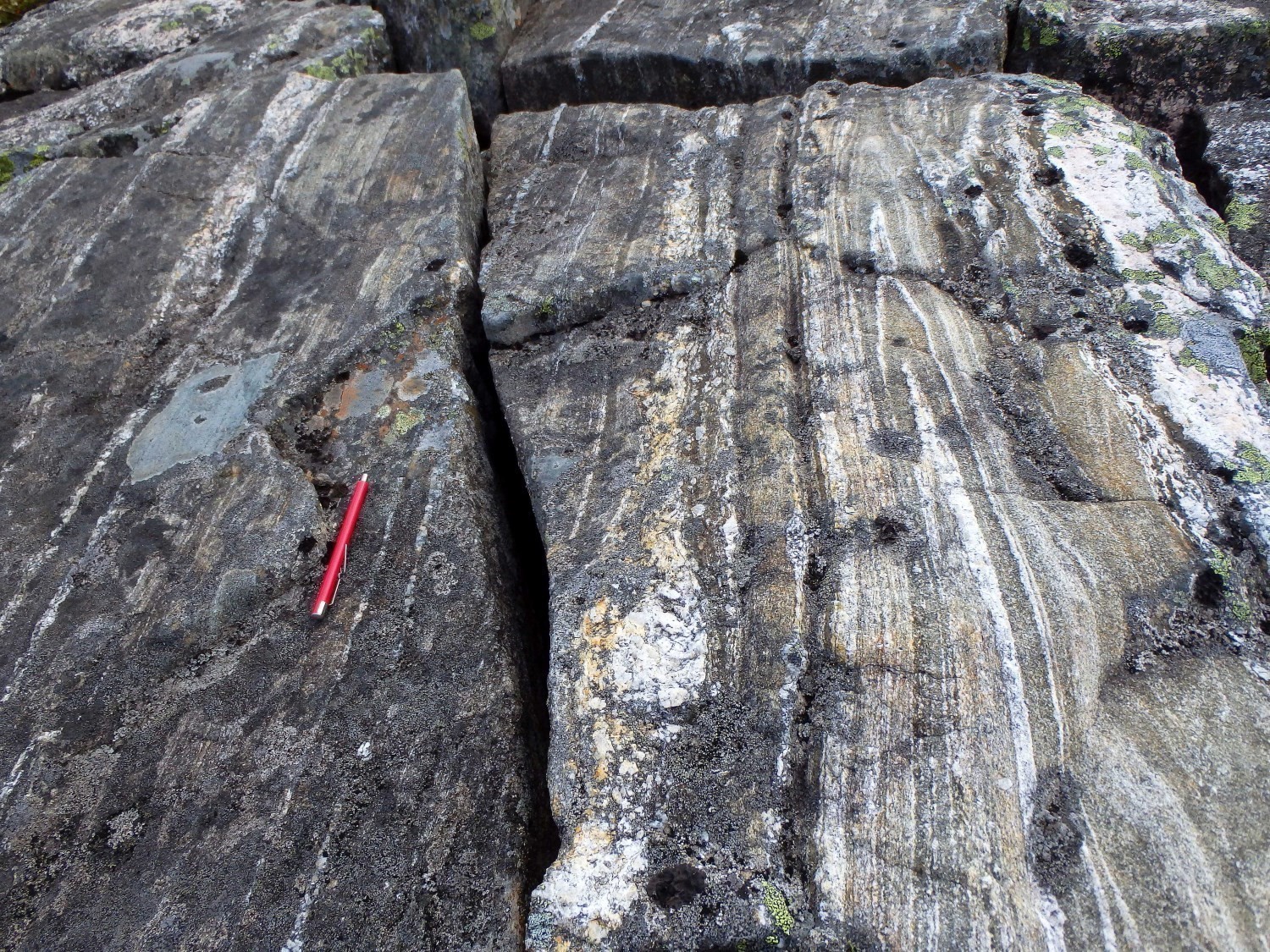| Author(s) | Ryan, 1990 |
| Methodology | Defined from a geological survey and geophysical data |
| Belonging | Churchill Province / George, Mistinibi-Raude and Falcoz lithotectonic domains |
| Main movement | Sinistral |
| Deformation style | Shearing |
| Metamorphic facies (mean facies related to main deformation) | Amphibolites |
Background and Methodology
The « Moonbase Deformation Zone » was identified by Ryan (1990) in the Kogaluk River area of Labrador. Initially, it was not described in Quebec and its NW extension was derived from aeromagnetic maps (Wardle et al., 1990, 2002). The NW portion of the Moonbase Zone was mapped by Lafrance et al. (2015, 2016) and renamed the Moonbase Shear Zone (ZCmob).
The structural and textural analysis of the ZCmob was the subject of a bachelor’s thesis (Côté-Roberge, 2015) and a master’s thesis (Vanier et al., 2017, 2018).
Boundaries and Morphology
| Width | ~10 km (maximum of 16 km) |
| Length | ~115 km |
| Orientation | NW-SE and NNW-SSE |
The ZCmob is generally oriented NW-SE and turns to the NSW-SSE in its eastern portion, where it joins the Blumath Shear Zone (ZCblm). The morphology of the ZCmob is similar to that of the Falcoz and Abloviak shear zones to the north. The ZCmob affects the structural grain of the Rivière George Shear Zone (ZCrge), which is redirected to the NW-SE in this area. Its western limit corresponds to the change in orientation of structures in parallel with the ZCrge NNW-SSE orientation. The ZCmob represents the boundary between the Archean-Paleoproterozoic Falcoz Lithotectonic Domain and the Neoarchean to Paleoproterozoic Mistinibi-Raude Lithotectonic Domain (Lafrance et al., 2019).
Stratigraphic Units Concerned
Marking the boundary between two lithotectonic domains, the ZCmob distorts units near the contact between the Mistinibi-Raude and Falcoz domains. In this way, it distorts the Kangiqsualujjuaq, Siimitalik and Fougeraye, and Pelland Suite in the Falcoz Domain, in addition to the Mistinibi Complex in the Mistinibi-Raude Domain. This shear zone also affects fabrics of certain units of the George Lithotectonic Domain, such as the Saint-Sauveur, Tunulic and Guesnier complexes, and De Pas Granitic Suite.
Structural Characteristics
❯ Main Fabrics
| Main Fabric | Type of Fabric | Direction (°) | Dip / Plunge (°) | Number of measurements | Comments |
| Foliation Sn | Mylonitic foliation or banding, gneissosity, tectonometamorphic foliation | 314 | 87 | 234 | |
| Lineation Ln | Secondary tectonometamorphic mineral lineation | 320 | 11 | 32 |
|
The ZCmob is characterized by well-developed mylonitic foliation or banding (Sn), as well as quartz rods (Ln) or bands, and porphyroclasts. Several decimetric to metric mylonite zones have C/S fabrics. At the junction with the ZCblm to the east, orthomylonites composed of nearly 50% of highly recrystallized matrix occur locally. Bands of broken granite containing K-feldspar or polymineralic porphyroclasts are also observed.
Textures associated with the main fabric include crenulation, undulatory extinction of feldspar crystals, microfractures in grains, dismemberment of microliths and grinding. Within microliths, evidence of dynamic recrystallization is observed such as wedged grain edges and, more locally, grain edge migration.
In its western section, the ZCmob transposes the ZCrge fabric. Within a kilometric strip, the ZCrge NNW-SSE fabric is reoriented to an NW-SE axis. This influence of the ZCmob on ZCrge fabrics is also observed on the vertical magnetic gradient map.
❯ Other Fabrics
Does not apply.
❯ Folds
Tight to isoclinal folds are commonly observed in ZCmob mylonitic zones. Their axial plane and fold axis are parallel to the main fabric (Sn and Ln respectively). The formation of these folds (Pn) therefore appears to be associated with the same transpression stress regime producing ZCmob mylonites.
❯ Cross-Cutting Relationships
Not observed.
❯ Kinematics
The main apparent movement of the ZCmob is sinistral. This is inferred by C/S shapes produced in the structural grain as observed on the aeromagnetic map, as well as kinematic indicators observed in outcrop and thin section. Although kinematic indicators indicate a generally sinistral apparent movement, dextral kinematic indicators are also observed. Sigmoid-shaped macroscopic and microscopic porphyroclasts are the most common kinematic indicators. Sigmoids are phi or delta type. Grain rotations, mica fishes and pressure shadows are also observed.
Deformation Style
The intensity of deformation within the ZCmob varies from protomylonites to localized zones of ultramylonites. The ZCmob is a sinistral shear zone that may be part of a conjugate deformation system with the ZCrge (Vanier et al., 2018). The angle between these two shear zones as well as their respective suggest that they belong to the same stress system. The geometry of this system is also consistent with the NE-SW orientation of extension fractures interpreted from geophysical lineaments locally occupied by dykes (Vanier et al., 2018). Although structural lineaments suggest that these two shear zones are synchronous, the concomitant deformation along these structures is, however, still to be demonstrated by geochronological data.
Metamorphic Characteristics
Metamorphic minerals are oriented in the mylonitic fabric and are affected by grain reduction or dynamic recrystallization in intensively deformed zones.
Alterations
Late alteration is observed locally on outcrops as hematite and epidote associated with fractures. This alteration and brittle deformation are superimposed on the mylonitic deformation.
Geophysical Characteristics
The magnetic pattern of the ZCmob is characterized by a succession of NW-SE to NNW-SSElinear magnetic ridges, where ridges of high magnetic susceptibility dominate. Within the George Lithotectonic Domain, the magnetic pattern varies from areas of high magnetic susceptibility to areas of low magnetic susceptibility, depending on lithologies crossed. Interpretation of aeromagnetic surveys determines the sinistral regional movement of shearing.
Chronological Markers
A very limited number of chronological markers are available to constrain the age of the ZCmob deformation. A crystallization age of 1861.7 ±4.7 Ma was obtained from U-Pb analyses on zircons in protomylonitic granodiorite (David, personal communication, 2018). Lafrance et al. (2016) interpret its emplacement as syntectonic, which implies that the shear zone was already active at that time.
Late granites of the De pas Granitic Suite (unit pPdep4) are not affected by the ZCmob mylonitic deformation. Their crystallization age estimated between 1820 Ma and 1805 Ma represents the minimum age for this deformation.
References
Publications available through Sigéom Examine
Charette, B., Lafrance, I., Vanier, M.-A. 2018. Domaine de George, sud-est de la Province de Churchill, Nunavik, Québec, Canada : synthèse de la géologie. MERN. BG 2018-11
Charette, B., Lafrance, I., Vanier, M.-A., Godet, A. 2019. Domaine de Mistinibi-Raude, sud-est de la Province de Churchill, Nunavik, Québec, Canada : synthèse de la géologie. MERN. BG 2019-07, 1 plan.
LAFRANCE, I., BANDYAYERA, D., BILODEAU, C. 2015. GEOLOGIE DE LA REGION DU LAC HENRIETTA (SNRC 24H). MERN. RG 2015-01, 62 pages and 1 plan.
LAFRANCE, I., BANDYAYERA, D., CHARETTE, B., BILODEAU, C., DAVID, J. 2016. GEOLOGIE DE LA REGION DU LAC BRISSON (SNRC 24A). MERN. RG 2015-05, 64 pages and 1 plan.
VANIER, M.-A., GODET, A., GUILMETTE, C., HARRIS, L B., CLEVEN, N R., CHARETTE, B., LAFRANCE, I. 2018. Extrusion latérale en croûte moyenne dans le sud-est de la Province de Churchill démontrée par les interprétations géophysiques, l’analyse structurale et les pétrofabriques du quartz. UNIVERSITE LAVAL, INRS, MERN. MB 2018-12, 58 pages.
VANIER, M A., GUILMETTE, C., HARRIS, L., GODET, A., CLEVEN, N., CHARETTE, B., LAFRANCE, I. 2017. ANALYSE STRUCTURALE ET MICROSTRUCTURES DES ZONES DE CISAILLEMENT DE LA RIVIERE GEORGE ET DU LAC TUDOR. UNIVERSITE LAVAL, INRS, MERN. MB 2017-12, 50 pages.
Other publications
CÔTÉ-ROBERGE, M. 2015. Zone de cisaillement de la Province du Churchill. Bachelor’s thesis, Université Laval, 90 pages.
RYAN, B. 1990. Does Labrador-Québec border area of the Rae (Churchill) Province preserve vestiges of an archean history? Geoscience Canada; volume 17, pages 255-259.
WARDLE, R.J., RYAN, B., ERMANOVICS, I. 1990. The eastern Churchill Province, Torngat and New Québec orogens: an overview. Geoscience Canada; volume 17, pages 217-222.
WARDLE, R.J., JAMES, D.T, SCOTT, D.J., HALL, J. 2002. The southeastern Churchill Province : synthesis of a Paleoproterozoic transpressional orogen. Canadian Journal of Earth Science; volume 39, pages 639-663. doi.org/10.1139/e02-004






